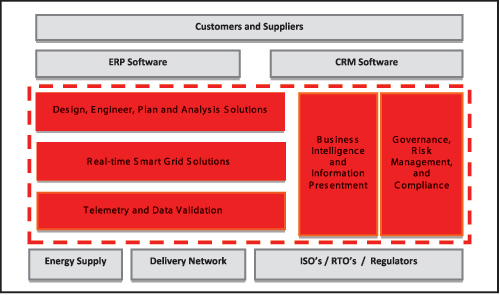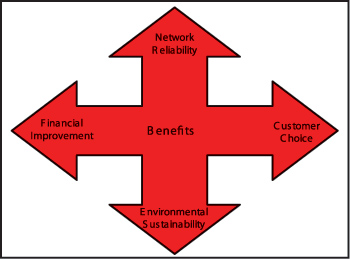When implementing Smart Grid technology, there is certainly no shortage of ideas regarding where to begin and how best to realize the benefits. With so many projects occurring at once and with federal Stimulus funds supporting them, the focus has been on job creation and the societal benefits of the Smart Grid, rather than the business case. By contrast, Telvent has worked with utilities around the world to help provide advice and direction to their Smart Grid business case studies, particularly those providing tangible value. That knowledge and background, combined with the experience among utilities that have begun to deploy Smart Grid Solutions, form the basis for this discussion of the business case for Smart Grid and how to extract tangible value from it.

Andy Zetlan
Smart Grid Solutions
Telvent
Smart Grid defined
There is no question that the Smart Grid is a broad topic and its definition often varies from region to region. However, in framing this discussion, it is important to define the functions that are included and the relevant sources of benefits. Figure 1 (below) illustrates an overview of a Smart Grid Solution, the key components of which are shown in orange.

Figure 1: Overview of the Smart Grid Solution
The key functional areas of the Smart Grid include:
• Telemetry and Data Validation: Data from AMI and SCADA networks, along with data from external systems and organizations such as weather forecasts, ISO and RTO communications, energy trading data sources and relevant news.
• Real-time Smart Grid Solutions: Real-time processes such as those contained in SCADA/EMS and other functions that manage real-time events (including outage management, etc.).
• Design, Engineer, Plan and Analyze Solutions: Various systems used to plan, design, and analyze the delivery network. Such analysis can focus on time periods in the past or future, depending on the need.
• Business Intelligence and Information Presentment: Software that can look across multiple types of data to produce the management information needed for smart operation of the delivery network, including the data that demonstrates the tangible benefits of the Smart Grid enterprise.
• Governance, Risk Management, and Compliance: Securing the data and its access to ensure the integrity of information, and providing compliance reporting to demonstrate successful data management.
A Smart Grid Solution uses a wide variety of information systems and telemetry, and interfaces with key “touch points” such as enterprise resource planning (ERP) systems and customer relationship management (CRM) systems that enable the utility organization to function.
The Smart Grid Business Case
Benefits accrue to the organization from four key sources, as seen in Figure 2.
• Financial Improvement: The improvement of revenues and the lowering or deferral of expenses.
• Network Reliability: Smart Grid Solutions are all about the energy delivery network and its reliability. Most Smart Grid Solutions focus on the distribution networks, where load growth continues and distributed generation is located. The distribution network is where the action is today and in the near future.
• Customer Choice: Smart Grid Solutions enable customer choice by providing data and options regarding energy delivery. Want cheaper rates? Want green energy? Want to help reduce electricity during peak times? Want to see how much the party last night added to the electric bill? Want to sample other rates and see which might be best for you? These and other opportunities await the customer whose utility has implemented a Smart Grid solution.
• Environmental Sustainability: Smart Grid Solutions enable utilities to meet environmental obligations and goals through smarter use of resources, helping to use natural resources more efficiently and to support regional regulatory requirements.

Figure 2: Smart Grid Benefit Sources
Regardless of how tangible the business case, most will contain each of these elements. Further, the business case for Smart Grid should demonstrate tangible benefits – economic and societal – to ensure that the project is worthwhile. The business case should also include the functionality to demonstrate that the value of the Smart Grid Solution is actually achieved.
Tangible Benefits of a Smart Grid
The next few paragraphs explore the types of tangible benefits utilities are actually achieving. For most utilities, only a subset of this list matters and the most relevant items depend on priorities in the individual utility’s market.
Financial improvement
Utilities have found that Smart Grid projects can positively impact many areas of financial performance. These include:
• Identification and reduction of losses: Most utilities take the reduction of losses into account, whether the losses occur within the network or through theft. Smart Grid Solutions typically help utilities pinpoint operational losses very accurately and can also help identify theft incidents. Both of these instances reduce losses and can also account for varying levels of added revenue, depending on the source of the loss.
• For utilities in parts of the world where losses are significant (e.g., in excess of 10 percent), Smart Grid Solutions should provide more rapid identification of problems and enable effective responses, increasing revenues and lowering losses to reasonable levels. In fact, reduction of losses alone can often overcome a significant portion of costs in the business case for Smart Grid.
• Reduction in outages and in the time to resolve outages: Utilities with modern Smart Grid solutions are more aware of issues on their distribution delivery networks and can act to correct those problems prior to an outage. While Smart Grid solutions cannot predict outages caused by other problems (e.g., severe weather), resolution of outages and the ability to more quickly identify faults, isolate them and achieve restoration saves costs and may enhance revenues.
• Reduction in outages and general improvement in reliability varies in need across regions of the globe. The pressure to reduce outages is often less financial than societal and is often required by governments.
• Enablement of demand response: Utilities use demand response at the consumer level to save money by reducing peak demand and to make electricity available for more profitable use. Demand response systems, which are generally used in conjunction with customer incentives, enable utilities to have more control at both peak times and as of spot markets change. In fact, many utilities are making this benefit the driving issue in the initial implementation of their Smart Grid Solutions.
• Utilities are generally approaching demand response through the implementation of home devices that can interrupt water heaters, air conditioners and pool pumps, and which can often reset or override temperature settings on thermostats. However, such devices require significant networks and software to operate, which creates a costly system for a much-needed benefit.
• Demand response may also have significant benefits due to the reduced cost of energy production.
• Enables Distribution System Demand Response (DSDR): Utilities are approaching DSDR as a key approach to the reduction of peak power and the addition of fast-responding spinning reserve. In a DSDR model, utilities employ voltage reduction to reduce the amount of energy sent to the energy delivery network to satisfy customer need. Often characterized as a broad demand reduction activity, DSDR actually provides a gross reduction of power needed to satisfy demand through changing the voltage via tap-changer at the feeder transformer.
• To achieve the benefits of DSDR, utilities must first establish improved voltage management on key feeders to enable voltage reductions to occur without reaching dangerously low levels. For some utilities this means adding devices such as capacitors in the field to ensure a relatively flat voltage profile across the feeder.
• As an additional step, utilities also can install a large number of low-cost, next-generation RTUs with updated line sensor technology that enables more accurate telemetry of voltage and other data on feeders, which should help the smart grid environment function at peak effectiveness.
• Reduction of maintenance cost and activity: Smart Grid Solutions are generally more “self-healing,” which means they will react more automatically to changes in demand and supply by switching or turning on key devices as needed. Further, knowledge of possible overload situations and attention to circuit rebalancing will make it possible for feeder infrastructure to last longer without failure. Given the general level of maintenance performed each year, utilities are hoping that the Smart Grid Solutions implemented will lower those costs.
• Extending asset life: Utilities are learning to manage an array of asset types more wisely through their Smart Grid Solutions and it is expected that critical assets will be used more appropriately and last longer as a result. This will achieve lower cost overall, as assets will meet or exceed their expected engineering lives in the field. Utilities that are currently underperforming in the maintenance of their distribution systems might, however, see maintenance costs rise due to the awareness and correction of previously unknown problems.
Network Reliability
Utilities, particularly in the United States, already operate energy delivery networks at a very high degree of reliability. Over the past 100 years, engineers have designed a resilient network that has generally performed well.
However, this aging network is facing several challenges: It is beginning to show signs of aging in various places around the country and the introduction of distributed generation and larger demands (e.g., electric cars and their respective charging stations) will cause operational problems that will only increase over time.
Safeguarding network reliability enables the options that reduce cost and support the local economy, creating huge financial and societal impacts. However, in North America, the key to maintaining network reliability can be found in NERC rulings and fines that can ultimately impact the ability of the utility organization to continue its existence. Local government agencies and commissions will struggle with this issue, as new demands and energy supplies arrive on the distribution network, creating new and unstable operating conditions.
Gaining better understanding and control of the distribution network will also enable the economy of the utility’s region to grow and adapt to new technologies. The convenience of electric vehicle charging stations, the need for solar energy or wind power centers, and the expansion of our technology-based economy will all be better served with a high-reliability and strong, quality-based network that is more closely monitored and controlled.
Customer Choice
Smart Grid implementations can provide customers with both more choice and more responsibility for the effective use of energy. In the new energy economy, customers will have a larger choice of the pricing of electricity (rate selections) and can adapt to new pricing models as situations change both in supply and demand. Customers expecting a new child, for example, can change their electricity pricing along with the arrival of the baby and their new way of life.
Further, the potential of more real-time pricing exists, which will enable automated devices to respond on behalf of customers to shut down devices and electricity consumption at periods when prices are high. The new Smart Grid Solutions will enable utilities to provide pricing that will include not only the cost of the energy but the price for its transport, including additional pricing for contention on the delivery system during busy times.
Smart Grid Solutions also understand that customers do not fully grasp the complexities of grid management and that there can be contention pricing in one part of the network, even while the rest of the network is fairly contention-free. Similar to broadband carriers of today, utilities will have to pay attention to the management of distribution feeders at a far more detailed level than in the past to ensure that customers see a quality product at a reasonable price.
Customer choice is a significant goal and the building blocks are now being implemented to become the foundation for achieving this benefit. Having customers support demand response and act to improve the power factor can actually reduce utility cost while enhancing the overall network reliability and power quality.
Environmental Sustainability
Lastly, but in many regions the most important benefit, is achieving environmental sustainability. Enabling distributed generation may make electric operations more complex, but it also supports the movement to green power, which is strongly desirable. Postponing a fossil fuel power plant saves a tremendous amount of capital, but it also lowers the carbon and other emissions that are building up in our atmosphere.
Smart Grid Solutions are focused on managing costs, creating customer choice and enhancing network reliability, but not at the expense of the environment. Instead, Smart Grid Solutions are set in place to protect the environment and assure sustainable operation of our utilities.
Obtaining the Benefits of Smart Grid Solutions
With a clearer picture of the benefits, utilities can more clearly understand the approach that is needed for the implementation. Experienced utility customers have strong words of advice for those about to set out on this path:
1. Understand the Big Picture: Make certain that the Smart Grid Solutions environment is understood and the path to success is clear, including strong cost/benefit payback and societal impacts. Simply jumping in with a large AMI deployment may be politically expedient but may not bring the needed results.
2. Go After Low-hanging Fruit: Achieve your successes early to ensure program support and understanding. Don’t wait two years after a huge implementation of meters or other software, but instead fund closer objectives that lead to larger successes later. Build a track record of success by finding early wins and capturing them.
3. Start with Business Intelligence and Analytics: Understand your utility’s business and the business case for Smart Grid Solutions. Determine which key measures will spell success and then measure them and report on your progress regularly. Fix problems as you see them, but institute an auditing process as the program is created.
Summary
Smart Grid Solutions will be a key part of our lives over the coming decades, and as the world moves to newer paradigms for electricity delivery, customer choice, and sustainable electricity production, Smart Grid Solutions will help get us there. Benefits are clearly there in most regions of the world, but achieving them takes time and attention to the details of which projects to invest in and when. Creation of business intelligence and analytical systems around Smart Grid will provide the needed feedback to utilities, customers and the community as investments are made and results achieved.
About the Author
Andy Zetlan currently serves in Smart Grid Solutions at Telvent, providing expertise in the application of technology to smart grid implementations. He has spent his entire 35-year career in the utility industry, working for a utility, for utility industry consultancies, and for technology firms who serve the utility industry. He resides in Mountain View, California.







